This article was medically reviewed by Lacy Windham, MD. Lacy Windham, MD, is a Board-Certified Obstetrician & Gynecologist in Cleveland, Tennessee. Dr. Windham attended medical school at the University of Tennessee Health Science Center in Memphis. Her residency was completed at Eastern Virginia Medical School in Norfolk, Virginia. She was the recipient of multiple awards during her residency training, including Most Outstanding Resident in Maternal Fetal Medicine, Most Outstanding Resident in Oncology, Most Outstanding Resident Overall, and Special Award in Minimally Invasive Surgery.
There are 13 references cited in this article, which can be found at the bottom of the page.
wikiHow marks an article as reader-approved once it receives enough positive feedback. In this case, 87% of readers who voted found the article helpful, earning it our reader-approved status.
This article has been viewed 898,820 times.
Experts agree that the first symptom of syphilis is typically a red, painless sore on your genital area, which will go away in 3 to 6 weeks. Syphilis is a highly infectious sexually transmitted infection (STI) caused by bacteria, which is usually spread through vaginal, anal, or oral sex. You need medical treatment to recover from syphilis, which will continue to progress after the initial sore is gone. Studies show that syphilis can be cured, but you have to seek treatment early to prevent potentially life-threatening complications.[1] Try not to worry if you think you have syphilis, but do go see your doctor to start your road to recovery.
Steps
Identifying Syphilis Symptoms
-
1Understand how people get syphilis. Once you understand how people pass syphilis to one another, you can figure out whether you're at risk. The disease is transferred from one person to another through contact with a syphilis sore. These sores may appear externally on the penis and outer vaginal area, or internally in the vaginal canal, anus, and rectum. They may also be present on the lips and inside the mouth.
- If you've had vaginal, anal, or oral sex with someone infected with the disease, you are at risk of contracting syphilis.
- However, you need to come into direct contact with an infected lesion.[2] [3] Syphilis cannot be spread by shared eating utensils, toilet seats, doorknobs, hot tubs or swimming pools.
- Men who have sex with men (MSM) are significantly more likely to contract syphilis, with 75% of reported new syphilis cases in 2013. It's especially important to use safer sex practices if you are a man who has sex with men.[4]
-
2Be aware that syphilis carriers can go years without knowing they have it. The early stages of the disease do not have significant noticeable symptoms, and many people don't even know that they have syphilis.[5] Even if carriers do notice sores and symptoms, they may not recognize them as an STD, and may leave them untreated for long periods of time. Because the minor sores can progress gradually from 1-20 years after the initial infection, carriers may unknowingly pass the disease on to others.[6]
-
3Recognize the symptoms of primary stage syphilis. Syphilis has 3 stages: primary, secondary, and tertiary/late stage. The primary stage usually begins about 3 weeks after the first exposure to a syphilis sore. However, symptoms might begin to appear anywhere between 10 and 90 days after exposure.[7]
- The primary stage of syphilis most often begins with the appearance of a painless sore called a “chancre,” which is small, hard, circular, and painless. Although there is usually just one sore, there may be more.
- The sore appears where the disease entered the body. Common infection sites include the mouth, genitals, and anus.[8]
- The sore will heal on its own in 4 to 8 weeks, and won't leave a scar. However, this does not mean that the syphilis is gone. Without proper treatment, the infection simply moves on to the second stage.
-
4Tell the difference between primary and secondary stage syphilis. The secondary stage of syphilis usually begins 4 to 8 weeks after the initial infection, and lasts between 1 and 3 months.[9] This stage begins with a "maculopapular rash" on the palms of the hands and the soles of the feet. This type of rash doesn't usually itch, but causes rough, reddish brown spots on the skin.[10] Other rashes with a slightly different appearance may show up on other parts of the body at this time. People usually either don't notice these rashes or assume they have other causes. This usually results in delayed treatment of their actual cause.
- Other symptoms eventually appear in this stage as well. They too are sometimes mistaken for other problems, such as the flu or stress.
- These symptoms include: fatigue, muscle aches, fever, sore throat, headaches, swollen lymph glands, patchy hair loss, and weight loss.[11]
- About a third of those who don't get treatment during the secondary syphilis stage will develop latent or tertiary syphilis.[12] The latent stage is the symptom-less period that precedes the appearance of tertiary stage symptoms.
-
5Learn to identify the symptoms of latent and tertiary stage syphilis. The latent stage begins when the symptoms of stages 1 and 2 disappear. The syphilis bacteria is still in the body, but there are no longer any signs or symptoms of the disease. This stage can last for years. However, about a third of those who go untreated during the latent stage will develop the tertiary stage of syphilis, which has severe symptoms. Tertiary stage syphilis may not show itself until 10 to 40 years after the initial infection.[13]
- Tertiary stage syphilis can see damage to the brain, heart, eyes, liver, bones, and joints. This damage may be serious enough to cause death.
- Other symptoms of the tertiary stage include difficulty with muscle movement, numbness, paralysis, progressive blindness, and dementia.[14]
-
6Be vigilant for syphilis symptoms in babies. If a pregnant woman has syphilis, she can transfer disease-causing bacteria to the unborn child through the placenta. Proper prenatal care should help prepare your doctor for any complications. The most common symptoms seen in babies born with syphilis include:[15]
- Intermittent fevers
- Enlarged spleen and liver (Hepatosplenomegaly)
- Swollen lymph nodes
- Chronic sneezing or runny nose with no apparent allergic cause (persistent rhinitis)
- Maculopapular rashes on the palms and soles
Diagnosing and Treating Syphilis
-
1See your doctor if you suspect you may have syphilis. If you think you've come into contact with a syphilis sore, see a doctor immediately. Also see a doctor if you notice any unusual discharge, sores, or rashes, particularly in the genital area.
-
2Get tested routinely if you fall into "at risk" categories. The US Preventive Services Task Force (USPTF) strongly recommends that people in "at-risk" populations get tested for syphilis yearly, even if they don’t have symptoms. However, research has shown that if you're not “at risk,” there's no benefit to regular syphilis screening. In fact, it can lead to unnecessary antibiotic treatment and anxiety.[16] You fall into the “at risk” category if:
- You engage in casual sex
- You have a sexual partner who's tested positive for syphilis
- You have HIV
- You are a pregnant woman
- You are a man who has sexual contact with men
-
3Get a blood test to confirm the diagnosis. The most efficient way to test for syphilis is through a test for syphilis antibodies in the blood. The syphilis test is inexpensive and easy to perform; you can have it done at a doctor's office or public health clinic. The clinicians will use one of the following methods to look for syphilis antibodies in your blood:
- Nontreponemal tests: These tests are ideal for screening purposes, and are about 70% accurate. If the test has a positive result, the doctor will confirm the diagnosis with a treponemal test.[17]
- Treponemal tests: These tests for antibodies are more specific, and are used for confirmation rather than screening.
- Some clinicians test for syphilis by taking a sample from a suspected syphilis sore. They inspect the sample under a specialized microscope to look for treponema pallidum, the bacteria that causes syphilis.[18]
- All patients should be tested for HIV infection. [19]
-
4Receive antibiotic treatment. Syphilis is relatively simple to treat and cure with proper medical attention. The earlier the syphilis is diagnosed, the easier it is to treat; if treated within a year, a single dose of penicillin can completely cure the disease. Antibiotics can be very effective in early syphilis infection, but may have less of an effect in late syphilis.[20] People who've had the disease longer than a year may need multiple doses of antibiotics. Patients with latent or tertiary phase syphilis will likely need 3 doses per week.[21]
- Let your doctor know if you are allergic to penicillin. He or she will likely recommend a 2-week treatment of doxycycline or tetracycline instead. Note that these alternatives may not be suitable for pregnant women, due to the risk of birth defects.[22] If pregnancy is an issue, your doctor will discuss additional treatment options with you.
-
5Do not try to treat syphilis on your own. Penicillin, doxycycline, and tetracycline work by killing the syphilis bacteria and eliminating it from the body. No home remedies or over-the-counter medications will work. Only a physician can prescribe the drug dosage necessary to cure the disease.
- Although the medications will cure syphilis, they cannot repair damage that's already been done.
- Note that testing and treatment is similar for babies.
-
6Allow the doctor to track your progress. After you've completed your treatment, your doctor will repeat the nontreponemal tests every 3 months. This will allow him or her to monitor your response to treatment. If the test results don't show improvement within 6 months, this could suggest inadequate treatment or a recurrent infection that needs to be dealt with.[23]
-
7Abstain from sex until the infection has cleared. It's extremely important that you don't have sex while still undergoing treatment — especially with new partners. Until your sores have healed and a physician has declared you syphilis-free, you risk passing it to someone else.[24]
- You should also notify all previous sexual partners of your diagnosis, so they can also be tested and treated for syphilis.
Preventing Syphilis
-
1Use latex or polyurethane condoms or dental dams. Wearing condoms during vaginal, anal, or oral sex can reduce the risk of contracting syphilis. However, the sore or site of infection must be completely covered by the condom. Always use a condom with new sexual partners, as they may not even know whether they have syphilis — especially if there are no visible sores.
- Be aware that you may still contract syphilis if the sore is not completely covered by the condom.
- It's preferable to use dental dams for oral sex with women, as they usually cover a larger area than condoms that have been cut open. However, if you don't have a dental dam, you can cut open a male condom and use it instead.
- Latex and polyurethane condoms offer equal protection against STDs and HIV. "Natural" or "lambskin" condoms do not adequately protect against STDs.[25]
- Use a new condom for each sex act. Don't reuse condoms, even for different types of penetration (vaginal, anal, oral) in the same sexual interaction.[26]
- Use water-based lubricants with latex condoms. Oil-based lubes such as petroleum jelly, mineral oil, or body lotion can weaken the latex and make you more likely to contract an STD.
-
2Avoid casual sex. You can't guarantee that casual sexual partners aren't carrying STDs. As such, it's best to abstain from casual sex. If you know for a fact that your partner has syphilis, you should avoid sexual contact with them entirely, even if they are wearing a condom.
- The safest option is to be in a monogamous, long-term relationship with a partner who has tested negative for syphilis and other STDs.
-
3Avoid excessive alcohol and drug use. The Centers for Disease Control and Prevention advise against the excessive use of alcohol and drugs. These substances can increase a person's likelihood of engaging in risky sexual behavior, which would place you in the "at risk" category.[27]
-
4Seek adequate prenatal care if you're pregnant. It is very important that pregnant women receive good prenatal care, which involves tests for syphilis. Healthcare professionals and the USPSTF recommend that all pregnant women get screened because syphilis can pass from a mother to her developing baby, causing serious illness and often death.[28]
- Babies who contract syphilis from their mothers are much more likely to be underweight, premature, or even stillborn.
- Even if the child is born without symptoms, untreated babies can develop serious health issues within a matter of weeks. These issues include deafness, cataracts, seizures, and potentially death.
- This can be avoided if the mother is tested for syphilis throughout the pregnancy and at the time of delivery. If the test comes back positive, both mother and baby can be treated.[29]
Warnings
- Genital chancres make it easier to transmit and acquire HIV infection during sexual activity.⧼thumbs_response⧽
- There are no home remedies or over-the-counter drugs that will cure syphilis.⧼thumbs_response⧽
- Condoms lubricated with spermicides are no more effective than other lubricated condoms in preventing the spread of STDs.⧼thumbs_response⧽
- Untreated syphilis in a pregnant woman can infect and possibly kill a developing baby.⧼thumbs_response⧽
References
- ↑ https://www.mayoclinic.org/diseases-conditions/syphilis/symptoms-causes/syc-20351756
- ↑ Agabegi, S. (2013). Step-up to medicine (3rd ed.). Philadelphia: Wolters Kluwer/Lippincott Williams & Wilkins.
- ↑ https://www.nhs.uk/conditions/syphilis/
- ↑ http://www.cdc.gov/std/syphilis/stdfact-syphilis-detailed.htm
- ↑ https://www.nhs.uk/conditions/syphilis/
- ↑ Agabegi, S. (2013). Step-up to medicine (3rd ed.). Philadelphia: Wolters Kluwer/Lippincott Williams & Wilkins.
- ↑ Agabegi, S. (2013). Step-up to medicine (3rd ed.). Philadelphia: Wolters Kluwer/Lippincott Williams & Wilkins.
- ↑ Agabegi, S. (2013). Step-up to medicine (3rd ed.). Philadelphia: Wolters Kluwer/Lippincott Williams & Wilkins.
- ↑ Le, T., & Bhushan, V. (2010). First aid for the USMLE step 2 CK (7th ed.). New York: McGraw-Hill Medical.
- ↑ Le, T., & Bhushan, V. (2010). First aid for the USMLE step 2 CK (7th ed.). New York: McGraw-Hill Medical.
- ↑ Le, T., & Bhushan, V. (2010). First aid for the USMLE step 2 CK (7th ed.). New York: McGraw-Hill Medical.
- ↑ Le, T., & Bhushan, V. (2010). First aid for the USMLE step 2 CK (7th ed.). New York: McGraw-Hill Medical.
- ↑ Agabegi, S. (2013). Step-up to medicine (3rd ed.). Philadelphia: Wolters Kluwer/Lippincott Williams & Wilkins.
- ↑ http://www.cdc.gov/std/syphilis/stdfact-syphilis.htm
- ↑ Stead, L., & Kaufman, M. (2011). First aid for the pediatrics clerkship (3rd ed.). New York: McGraw-Hill Medical.
- ↑ http://www.ncbi.nlm.nih.gov/pmc/articles/PMC1466700/
- ↑ Agabegi, S. (2013). Step-up to medicine (3rd ed.). Philadelphia: Wolters Kluwer/Lippincott Williams & Wilkins.
- ↑ https://www.nhs.uk/conditions/syphilis/
- ↑ Agabegi, S. (2013). Step-up to medicine (3rd ed.). Philadelphia: Wolters Kluwer/Lippincott Williams & Wilkins.
- ↑ Agabegi, S. (2013). Step-up to medicine (3rd ed.). Philadelphia: Wolters Kluwer/Lippincott Williams & Wilkins.
- ↑ Agabegi, S. (2013). Step-up to medicine (3rd ed.). Philadelphia: Wolters Kluwer/Lippincott Williams & Wilkins.
- ↑ http://www.cdc.gov/std/syphilis/the-facts/syphilis_2010_508_final.pdf
- ↑ Agabegi, S. (2013). Step-up to medicine (3rd ed.). Philadelphia: Wolters Kluwer/Lippincott Williams & Wilkins.
- ↑ Agabegi, S. (2013). Step-up to medicine (3rd ed.). Philadelphia: Wolters Kluwer/Lippincott Williams & Wilkins.
- ↑ https://www.nhs.uk/conditions/syphilis/
- ↑ https://www.plannedparenthood.org/learn/stds-hiv-safer-sex/syphilis/how-is-syphilis-prevented
- ↑ http://www.cdc.gov/std/syphilis/stdfact-syphilis.htm
- ↑ http://www.ncbi.nlm.nih.gov/pmc/articles/PMC1466700/
- ↑ https://www.plannedparenthood.org/learn/stds-hiv-safer-sex/syphilis
About This Article
Syphilis is a sexually transmitted disease that can seriously damage your nerves and all organs in your body if left untreated, so it's important to identify the symptoms. Syphilis is transmitted when someone comes into contact with an infected lesion during sex, so you’ll be at risk if you’ve had vaginal or anal sex with someone who’s infected. The first sign you have syphilis is the appearance of a small sore where it entered the body, most likely on your genitals, mouth, or anus. The secondary stage of syphilis begins with reddish brown-spotted rashes on the palms of your hands and soles of your feet. Other symptoms at this stage include fatigue, muscle soreness, and a sore throat. When these symptoms disappear, someone with syphilis is in the latent stage of the disease. This can last for many years, but about one third of people who remain untreated are likely to contract tertiary syphilis, which has severe symptoms. These include blindness, numbness in muscles, damage to bones and organs, and, in serious cases, death. For tips from our medical co-author on how to get treatment for syphilis, keep reading.
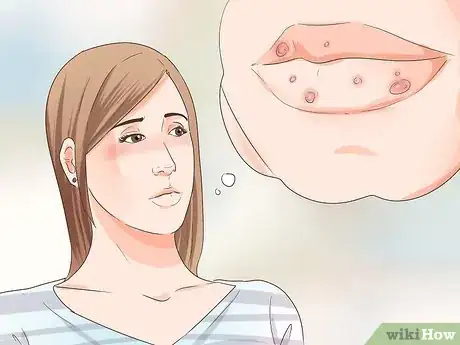


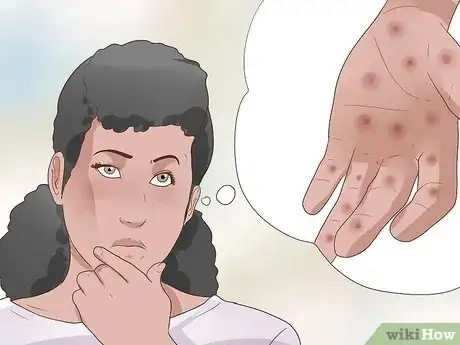



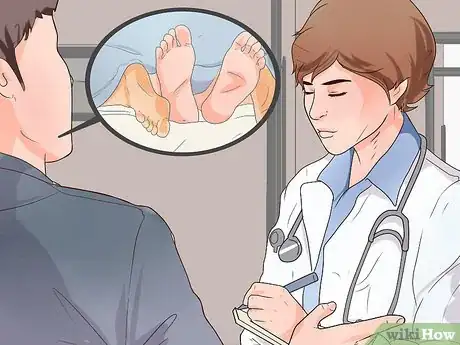





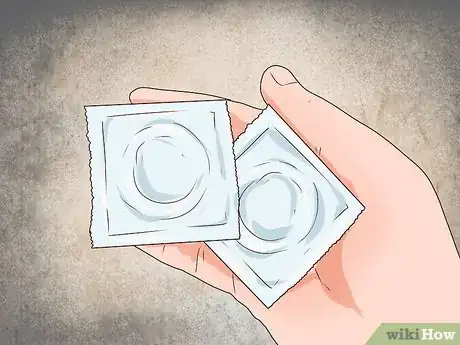






-Step-17.webp)


-Step-11-Version-2.webp)



-Step-10.webp)
-Step-13.webp)

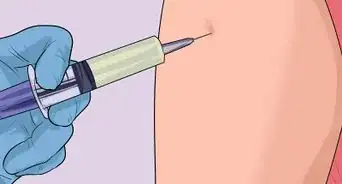












-Step-17.webp)



































Medical Disclaimer
The content of this article is not intended to be a substitute for professional medical advice, examination, diagnosis, or treatment. You should always contact your doctor or other qualified healthcare professional before starting, changing, or stopping any kind of health treatment.
Read More...